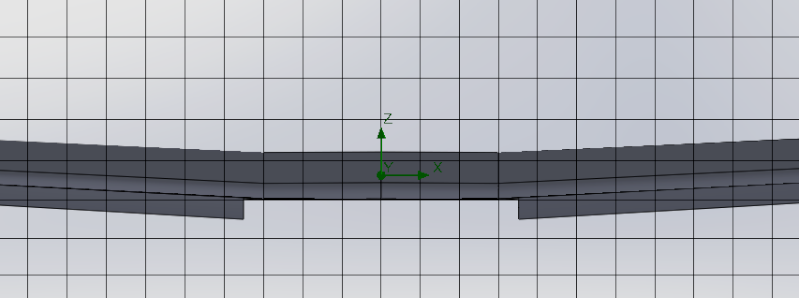 |
|
|
[Sponsors] | |||||
|
|
|
#1 |
|
New Member
Join Date: Sep 2009
Posts: 7
Rep Power: 16  |
Hi all,
I'm trying to run a CFD simulation over a 3D complex wing with flaps on. My goal is to plot the Cl-alpha graph for different angles of attack at 80km/h (that is the stall configuration for a 15m class sailplane). My settings for the turbulence parameters are: length scale = 20% of wing chord intensity = 5% but i got understimated results. Do you have any suggestion? I use Flow Simulation because is more easy to set and more user friendly. |
|
|
|

|
|
|
|
|
#2 |
|
Senior Member
|
5% intensity is too much. For a sailplane it is a fraction of a percent something around 0.07-0.01% or even less.
Also cfd with turbulence modelling for low reynolds numbers has usually nothing to do with reality. Xfoil or Xflr-5 will give much better results for a sailplane. |
|
|
|

|
|
|
|
|
#3 |
|
New Member
Join Date: Sep 2009
Posts: 7
Rep Power: 16  |
Xfoil or Xflr5 should not be used for a real sailplane design. I'm talking about a class 15 meters sailplane with a chord at root of 0.84m because they cannot account high Re numbers: 80km/h is not a such hight velocity but on a 0.84m chord gives over 1,200,000 Re that is too much for them.
In addition Xfoil or Xflr-5 use a potential method so they cannot account the real value of drag and they are not so much accurate on separation. Am i wrong? I thought 5% could be ok in according to the big zone of separation and turbulence in the stall condition but i am really not sure about that. I will try with the value you suggested. I'm also searching the problem into the mesh resolution:  I'm almost sure that is not correct at all... i didn't expect that auto mesh resolution could give this kind of result! |
|
|
|

|
|
|
|
|
#4 |
|
Senior Member
|
Turbulence intensity is intensity at inlet, i.e. free stream turbulence which does not depend on details downstream, i.e. at the wings.
The numbers for turbulence intensity are taken from papers on e^N transition models. N is liearly related to log of intensity, i.e. N=A+B log Tu, For instance looking to the table here http://www.dept.aoe.vt.edu/~simpson/...teup_v7WJD.pdf, one gets Tu%=0.07 for N=9, and Tu%=0.046 for N=10. According to x-foil manual, for a sailplane N=12-14, so one expects Tu% about 0.01%. X-foil and Xflr5 are more accurate on separation than cfd, if the separation is moderate (separation analysys is implanted into the programs). They even did some modification for accounting cose to stall regime. These programs work for re up to several millions and even have compressibility corrections. You can google on full scale sailplane or wind turbine analysys with x-foil and xflr and you will find examples. They cannot however account for stalling, big vorticity, large turbulence and large separation regions and fuselage. They also do no account very good for 3D effects close to wingtips. |
|
|
|

|
|
|
|
|
#5 |
|
Member
Geon-Hong Kim
Join Date: Feb 2010
Location: Ulsan, Republic of Korea
Posts: 36
Rep Power: 16  |
Dear Rizz,
I'm wonder what is the reference of your solution. Is it an experimental data or another numerical result? Whatever you compared your results to experimental data or numerical results, you have to set your inflow condition to be coincide with the reference case. After that you can say that your solution under or over estimates. I mean that the accuracy of the solution you've got is not the matter of turbulence intensity only. Furthermore, turbulence intensity does not occasionally play an important role to get 'accurate solution' in such simulations. Rather grid, schemes or turbulence models with wall boundary conditions are much more important features. I'd recommend you to study the influence of the turbulence intensity at inlet plane by varying its value from 0.01 to 0.1 if you are wondering the turbulence BC's at inflow plane. |
|
|
|

|
|
|
|
|
#6 |
|
New Member
Join Date: Sep 2009
Posts: 7
Rep Power: 16  |
I have not an experiment data as comparison for my CFD study, mine is just a first evaluation: the wing was designed using a well known airfoils and adding some features (wing twist, Dihedral angle, etc) to have a better performance.
As result, the wing is quite similar to the other common modern sailplanes in which the stall velocity has to be 80km/h for JAR-22 requirements. I'm just new on CFD, i think my problem could be the mesh geometry grid (that i cannot increase too much otherwise my 8GB RAM will be not sufficient, also if i thicken more only the part near wing) or the inlet condition that actually i don't know how to set. As the turbulence intensity value goes higher (until a certain limit), the higher will be the value of lift; in my case this is true globally. |
|
|
|

|
|
 |
|
|
 Similar Threads
Similar Threads
|
||||
| Thread | Thread Starter | Forum | Replies | Last Post |
| Turbulent Length Scale and Intensity for Airfoil | shamim | STAR-CCM+ | 2 | July 12, 2017 23:11 |
| Turbulence length scale and integral length scale | rizhang | CFX | 2 | April 22, 2016 07:22 |
| turbulence intensity and length scale | mohammad | FLUENT | 0 | January 7, 2012 08:57 |
| Turbulence intensity and length scale | eslam | CFX | 3 | January 14, 2008 16:37 |
| Turbulence intensity scale | Mirek | FLUENT | 1 | May 26, 2004 08:27 |